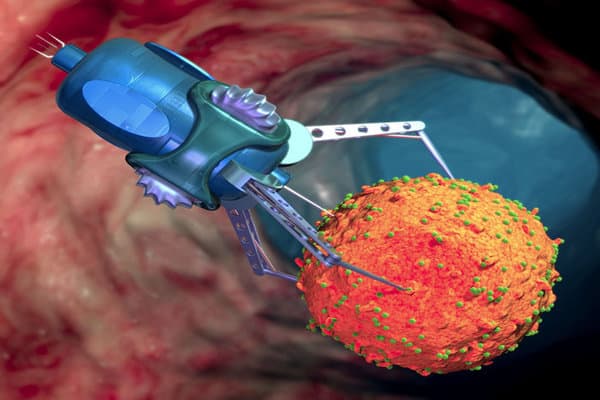These Origami-Inspired Micro Bio-Bots Will Heal You With Its Reconfigurable Nature
The maverick growth of nanorobotics in the field of biotechnology and health science has taken us one step forward to hit the technological singularity. At this point, we are in the growth phase and the most suitable time to invest all resources over miniature bots that could empower our health system by means of its minimally invasive applications.
Globally they are accepted as the mini sized army of doctors who enter inside of a body to treat variety of diseases by directly hitting the target section. Biochemically, a tablet that we ingest does not directly work on the section it should. It indirectly imposes its toxicity over organs where it is not required and that’s where a side-effect generates to bug you throughout your medicine cycle and after that in the post period.

These robots, scientifically micro/nano scaled machines go inside of a body, colonize the specific targets and spreads the drug on it. Not only that, they are also capable of performing precise operations like clearing clogged-up arteries etc. Such advantages pushed the Ecole Poletechnique scientist Selman Sakar to join hands with Hen-Wei Huang and Bradley Nelson at ETH Zurich to develop quality methods to achieve remote controlled bio-bots coupled with significant machinery.
Furthermore, they have designed a special platform that specifically tests locomotion of animals and imposes mobility criteria, forcing heat to shape-shift. Particularly, these bots are microscaled and soft, flexible, and motor-less in nature unlike its contemporary. EPFL+ETHZ venture bots are composed of a core made of biocompatible hydrogels upon which magnetic nanoparticles are distributed using an electric field. Nanoparticles actually accomplish both works simultaneously by providing a definite shape and also, incorporating an agility to swim through the applied magnetic field.
Once the initial processing is done, a polymerization step solidifies the bots and then they are plunged inside water to grow and gain a specific orientation that follows 3D architecture. As they become ready for the upcoming bio-inspired war, an electromagnetic field is applied to propel them and external heat is forced to help them unfold.
Their research is inspired by bacterium (Trypanosoma brucei) which causes sleeping sickness. The robots used as prototypes, have heat-sensitive flagellum similar to the bacterium that supports its swimming mechanism. Once inside, a Laser source is used to heat the flagellum and help them curl up to sport a hidden appearance. The second author of the respective paper explained that their specific production method allows one to test a series of shapes that could gear up the best motion capability for a certain task. The complete research has been published in Nature Communication.
Source: #-Link-Snipped-#
Globally they are accepted as the mini sized army of doctors who enter inside of a body to treat variety of diseases by directly hitting the target section. Biochemically, a tablet that we ingest does not directly work on the section it should. It indirectly imposes its toxicity over organs where it is not required and that’s where a side-effect generates to bug you throughout your medicine cycle and after that in the post period.

These robots, scientifically micro/nano scaled machines go inside of a body, colonize the specific targets and spreads the drug on it. Not only that, they are also capable of performing precise operations like clearing clogged-up arteries etc. Such advantages pushed the Ecole Poletechnique scientist Selman Sakar to join hands with Hen-Wei Huang and Bradley Nelson at ETH Zurich to develop quality methods to achieve remote controlled bio-bots coupled with significant machinery.
Furthermore, they have designed a special platform that specifically tests locomotion of animals and imposes mobility criteria, forcing heat to shape-shift. Particularly, these bots are microscaled and soft, flexible, and motor-less in nature unlike its contemporary. EPFL+ETHZ venture bots are composed of a core made of biocompatible hydrogels upon which magnetic nanoparticles are distributed using an electric field. Nanoparticles actually accomplish both works simultaneously by providing a definite shape and also, incorporating an agility to swim through the applied magnetic field.
Once the initial processing is done, a polymerization step solidifies the bots and then they are plunged inside water to grow and gain a specific orientation that follows 3D architecture. As they become ready for the upcoming bio-inspired war, an electromagnetic field is applied to propel them and external heat is forced to help them unfold.
Their research is inspired by bacterium (Trypanosoma brucei) which causes sleeping sickness. The robots used as prototypes, have heat-sensitive flagellum similar to the bacterium that supports its swimming mechanism. Once inside, a Laser source is used to heat the flagellum and help them curl up to sport a hidden appearance. The second author of the respective paper explained that their specific production method allows one to test a series of shapes that could gear up the best motion capability for a certain task. The complete research has been published in Nature Communication.
Source: #-Link-Snipped-#
Replies
You are reading an archived discussion.
Related Posts
which subject ask more question in interview?
Quote:
An engineer in the UK has found inspiration in nature for the design of bridges that are far stronger and more durable than current designs.
Emeritus Professor Wanda Lewis...
there are many branches and many more choices available in the b.tech.but the question is ,if i want to do my own business then which branch will be best for...
hello crazy engineer!! cn u guys guide me to do this..i just finish my last sem exam and get this job...im got no experience at all in this field TT...this...
Ex-Adobe Engineer Mayank Bhagya On Creating AI Powered App 'Siftr' To Keep Your Smartphone Junk-Free
Growing up in Jaipur with a middle class upbringing, Mayank Bhagya got the backing of a strong family foundation and good education - two factors that fanned his aspirations to...
